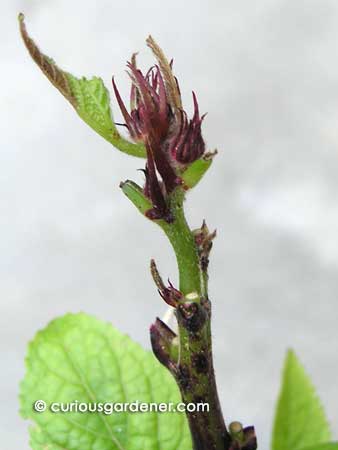
I like how the tomato flowers point downwards - it's so easy to imagine a nice, round tomato hanging in place!
As mentioned in a previous post, I have a couple of tomato plants growing. Like the pepper paprikas, I got these seeds from Thailand, so I don’t know if they’re any special kind of tomato. I’m just going to think of them as regular tomatoes and be done with that.
These weren’t easy to get started. I tried three times before I had a successful batch that actually grew. Since I had been anticipating a low or no germination rate, I’d tossed in quite a number of seeds. So, I ended up with quite a number of little sprouts growing. Me being me, I decided to experiment with the transplants at pricking out time.
For those of you who aren’t familiar with gardening terminology, pricking out is the process of transferring seedlings that have matured to true leaf stage (normally the second pair of leaves) to a bigger, individualized location where they have more space to grow. Seeds are sometimes germinated too close to each other and, if left alone, will choke each other when they grow into bigger plants.
Anyway, I decided to experiment by growing some plants in normal pots and media, and others in self-watering containers (SWCs). To my surprise, the ones in SWCs did much, much better than their pot-bound peers. They all had as much sunshine as the other, but the ones in SWCs had no worries about the scorching sun dehydrating them. I tossed out the ones in regular pots and focused on those in the SWCs since they were so much stronger.
When the first SWC plant got too root-bound, I transplanted it to a regular pot and put it out in the garden in a semi-shaded spot to adjust …and I promptly forgot about it until it had already sent roots through the drainage holes in the pot, and into the garden earth. Since it had set up home there, I left it alone and gave it a 1.2 metre high bamboo support stake to grow against. Of course, it’s not a twining plant, so I’ve had to periodically tie it loosely against the support.
It was on one such occasion last week that I noticed a small cluster of flower buds beginning to form at the growing tip. It took several days for the flowers to take shape and colour, but finally, there they were – little pale yellow flowers pointing downwards. I hope they don’t have trouble with pollination, because I can’t wait to see a bunch of tomatoes hanging in their place!
With luck, I’ll hopefully have another tomato update – of the fruity kind – in a couple of weeks…
© 2010 curiousgardener.com All rights reserved.



